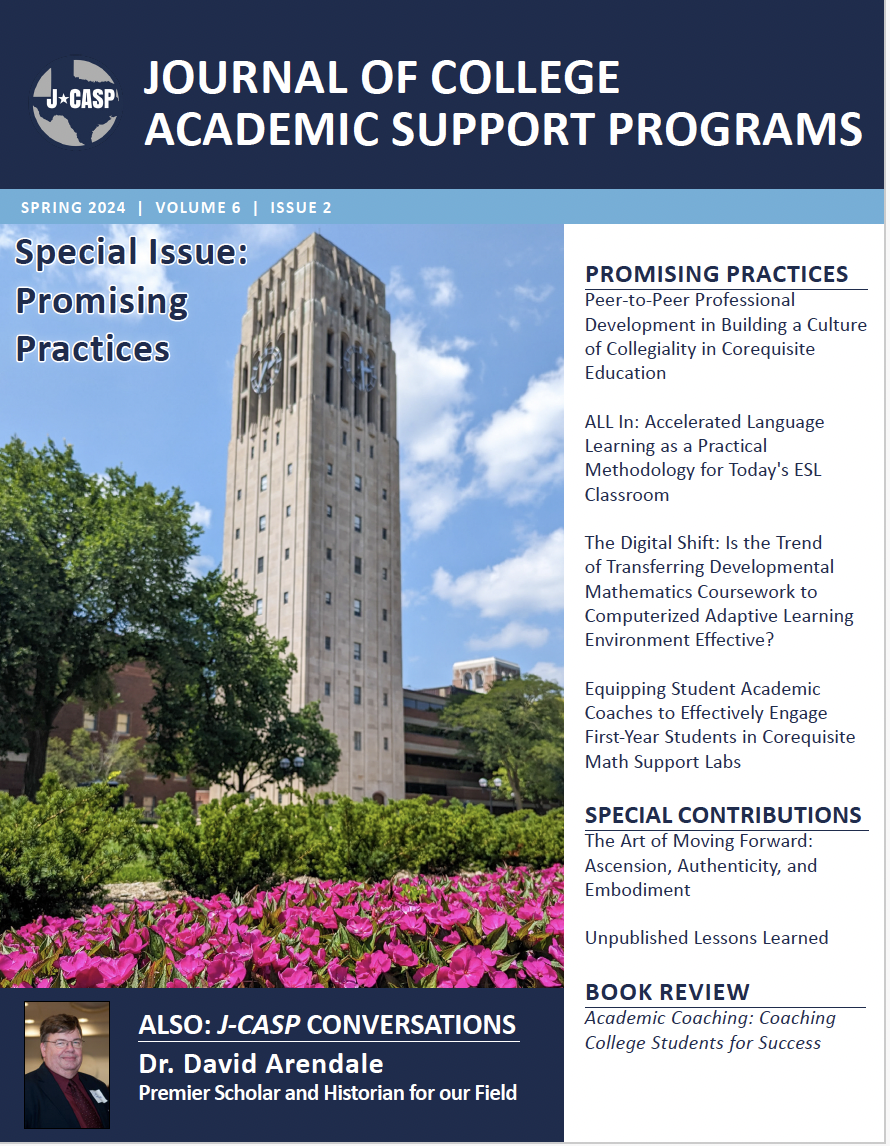ALL In: Accelerated Language Learning as a Practical Methodology for Today's ESL Classroom
DOI:
https://doi.org/10.58997/6.2pp2Keywords:
acceleration movement, California’s Community Colleges (CCC), English as a Second Language (ESL), transfer-level English classAbstract
The past 10 years have seen a major shift in English and English as a Second Language (ESL) placement and pedagogy in California’s Community Colleges (CCC), driven by a developmental education reform movement known as acceleration. Popularized by the faculty-led California Acceleration Project (CAP), the acceleration movement focused on reducing or eliminating prerequisite pathways in English and math due to a decade’s worth of state-wide data showing that each level of remediation statistically reduced a student’s chances of ever reaching or completing the first transfer-level course in the respective discipline (Hern & Snell, 2010). Faculty from many of the state’s 117 community colleges participated in CAP’s communities of practice, starting with the first cohort in the academic year 2011–2012, and returned to develop accelerated pathways at their own colleges. As these models proved successful and the data supporting acceleration mounted, CAP leaders joined forces with the College Futures Foundation and other partners to lobby for legislative action to compel a system-wide change. The resulting legislation, Assembly Bill 705 (Cal. Assemb., 2017), was signed into law in October 2017 and implemented as of January 1, 2018. This law required that all state community college districts maximize the probability that incoming students would access and complete their first transfer-level English and math class within a year of first enrolling and that students who enrolled in ESL courses would access and complete their first transfer-level English class within three years of first enrollment (Rodriguez et al., 2022).
References
Admin. (2022, October 10). The importance of grammar in English language. 21K School: World Class Education for Your World. https://www.21kschool.com/qa/blog/the-importance-of-grammar-in-english-language
Asher, J. (1969). The total physical response technique of learning. The Journal of Special Education, 3(3), 253–262. https://doi.org/10.1177/002246696900300304
Baranowska, K. (2020). Learning most with least effort: Subtitles and cognitive load. ELT Journal, 74(2), 105–115. https://doi.org/10.1093/elt/ccz060
Cal. AB 705, Reg. Sess. 2017–2018 (2017). https://legiscan.com/CA/bill/AB705/2017
Canale, M., & Swain, M. (1980). Theoretical bases of communicative approaches to Second Language teaching and testing. Applied Linguistics, 1(1), 1–47. https://doi.org/10.1093/applin/I.1.1
Celce-Murcia, M. (2014). An overview of language teaching methods and approaches. In M. Celce-Murcia, D. Brinton, & A. Snow (Eds.), Teaching English as a Second or Foreign Language (4th ed., pp. 2–14). National Geographic Learning.
Cook, V., & Cook, V. J. (1993). Linguistics and Second Language acquisition. Macmillan.
Ellis, R. (1994). The study of Second Language acquisition. Oxford University Press.
Ellis, R. (2020). In defense of a modular curriculum for tasks. ELT Journal, 74(2), 185–194. https://doi.org/10.1093/elt/ccaa015
Gattegno, C. (1972). Teaching foreign languages in schools: The silent way. Educational Solutions World.
Gregg, K. (1984). Krashen’s monitor and Occam’s razor. Applied Linguistics, 5(2), 79–100. https://doi.org/10.1093/applin/5.2.79
Hern, K., & Snell, M. (2010). Exponential attrition and the promise of acceleration in developmental English and math. https://rpgroup.org/Portals/0/Documents/Projects/California%20Acceleration%20Project%20%28CAP%29%20Evaluation/Hern%20Exponential%20Attrition.pdf
Hymes, D. H. (1979). On communicative competence. In C. J. Brumfit & K. Johnson (Eds.), The communicative approach to language teaching (pp. 1–26). Oxford University Press.
Jimenez, F. (1997). The circuit: Stories from the life of a migrant child. University of A new Mexican Press. Krashen, S., & Terrell, T. (1988). The natural approach— language acquisition in the classroom. Prentice Hall International.
Krashen, S. D. (2004). The power of reading: Insights
from the research. Libraries Unlimited. Krashen, S. (2020, May 18). Webinar with Stephen Krashen [Video]. YouTube. https://www.you-tube.com/watch?v=hSnGEGoUfL0
La Forge, P. G. (1971). Community language learning: A pilot study. Language Learning, 21(1), 45–61. https://doi.org/10.1111/j.1467-1770.1971.tb00489.x
Lei, W., & Wei, L. (2019). A critical evaluation of Krash- en’s monitor model. Theory and Practice in Language Studies, 9(11), 1459–1464, http://dx.doi.org/10.17507/tpls.0911.13
Lichtman, K. (2015). Research on TPR storytelling. In B. Ray & C. Seely (Eds.), Fluency through TPR story- telling (7th ed., pp. 364–380). Command Performance Language Institute.
Lozanov, G. (1978). Suggestology and outlines of suggestopedy (M. Hall-Pozharlieva & K. Pashmakova, Trans.). Gordon & Breach (Original work published 1971).
Lu, X. (2010). Automatic analysis of syntactic complexity in second language writing. International Journal of Corpus Linguistics, 15(4), 474–496.
McLaughlin, B. (1987). Theories of second language learning. Edward Arbold.
Mohan, B. A. (1986). Language and content. Addison-Wesley.
Python Package Index. (2023). NeoSCA 0.0.55. https://pypi.org/project/neosca/
Reeve, M. (2017, March 9). Acceleration in ESL: Making the case for accelerated pathways for English language learners. [Conference presentation]. Acceleration Across California First Annual Conference. https://app.box.com/v/CAPConference2017/file/147274452094
Rodriguez, O., Hill, L., Montoya-Payares, D., & Salazar, R. (2022). English as a Second Language at California’s community colleges: An early examination of AB 705 reforms. Public Policy Institute of California. https://www.ppic.org/publication/english-as-a-second-language-at-californias-community-colleges
VanPatten, B (2020). While we’re on the topic: BVP on language, acquisition, and classroom practice. American Council on the Teaching of Foreign Languages.
Zafar, M. (2009). Monitoring the ‘Monitor’: A critique of Krashen’s five hypotheses. The Dhaka University Journal of Linguistics, 2(4), 139–146. https://doi.org/10.3329/dujl.v2i4.6903
Downloads
Published
Issue
Section
License
Authors who publish with this journal agree to the following terms:
Authors retain copyright and grant the journal right of first publication with the work simultaneously licensed under a Creative Commons Attribution License that allows others to share the work with an acknowledgement of the work's authorship and initial publication in this journal.


